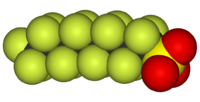
Photo from wikipedia
Per- and polyfluoroalkyl substances (PFAS) are organic chemicals with wide industrial and consumer uses. They are found ubiquitously at low levels in the environment and are detectable in humans and… Click to show full abstract
Per- and polyfluoroalkyl substances (PFAS) are organic chemicals with wide industrial and consumer uses. They are found ubiquitously at low levels in the environment and are detectable in humans and wildlife. Perfluorobutane Sulfonate (PFBS) is a short-chained PFAS used to replace perfluorooctane sulfonate in commerce. In general, the rate of clearance for the short-chained PFAS is faster than that for the long-chained congeners. This study evaluated the pharmacokinetic properties of PFBS and its hepatic transcriptional responses in CD-1 mice. Males and females were given PFBS by oral gavage at 30 or 300 mg/kg; controls received 0.5% Tween-20 vehicle. Trunk blood was collected at 0.5, 1, 2, 4, 8, 16 and 24 h thereafter; liver and kidney were also harvested. Serum and tissue concentrations of PFBS were determined by HPLC-MS-MS. Expression of several hepatic nuclear receptor target genes was determined by qPCR. The half-life of PFBS was estimated as 5.8 h in the males and 4.5 h in the females. Tmax was reached within 1-2 h. Volume of distribution was similar between the two sexes (0.32-0.40 L/kg). The rate of PFBS clearance was linear with exposure doses. Within 24 h, serum PFBS declined to less than 5% of Cmax. PFBS was detected in liver or kidney, although tissue levels of the chemical were only a fraction of those in serum. At 24 h after administration of 300 mg/kg PFBS, elevated expression of several hepatic genes targeted for PPARα, PPARy, and PXR but not by AhR, LXR or CAR was observed, with responses indistinguishable between males and females. Little to no transcriptional response was seen with the 30 mg/kg dose. The short serum half-lives of PFBS (4-5 h) in mice were comparable to those reported in rats. Although detection of PFBS in liver was low compared to that in serum even at the 300 mg/kg dose, the tissue level was sufficient to activate several hepatic nuclear receptors, which may represent an acute response to the chemical at a high dose.
Journal Title: Toxicology
Year Published: 2020
Link to full text (if available)
Share on Social Media: Sign Up to like & get
recommendations!